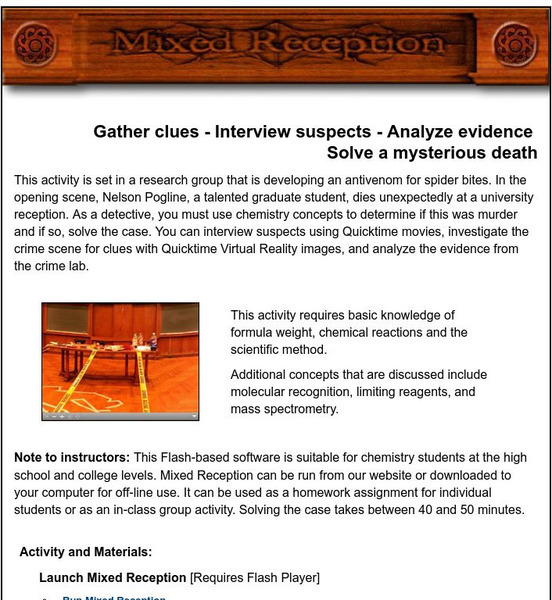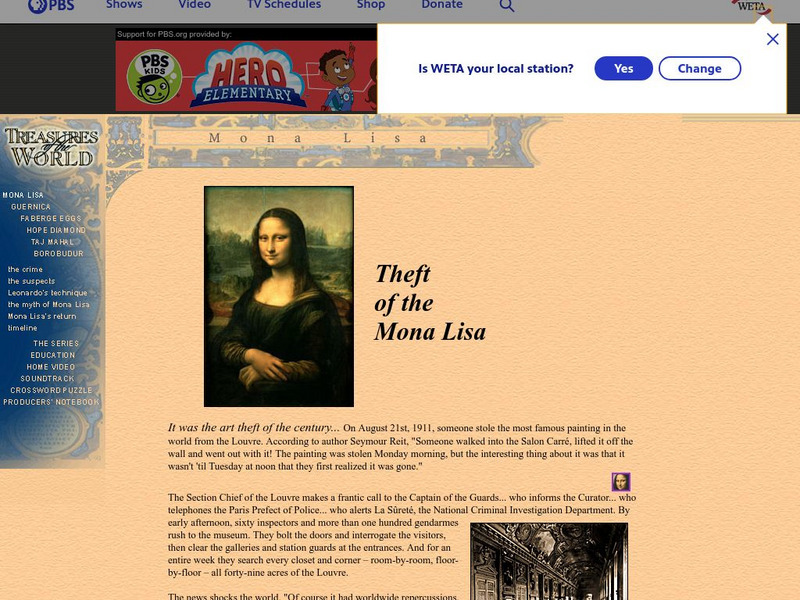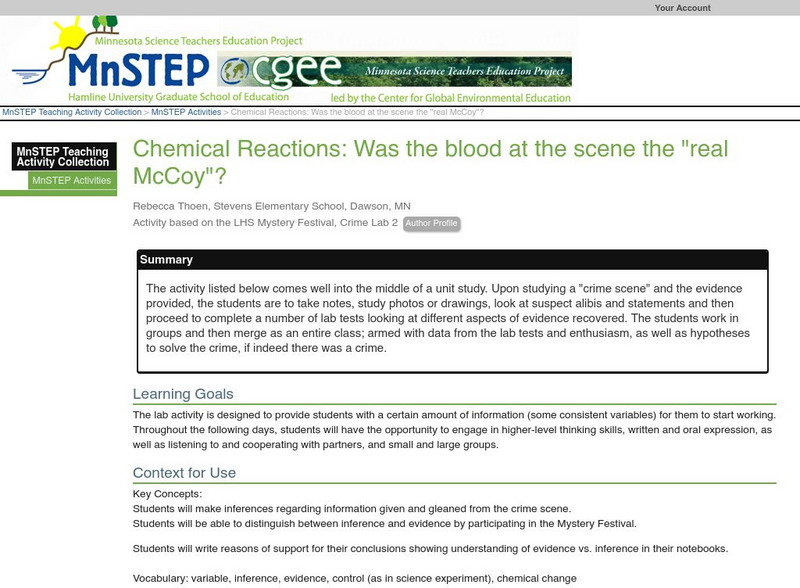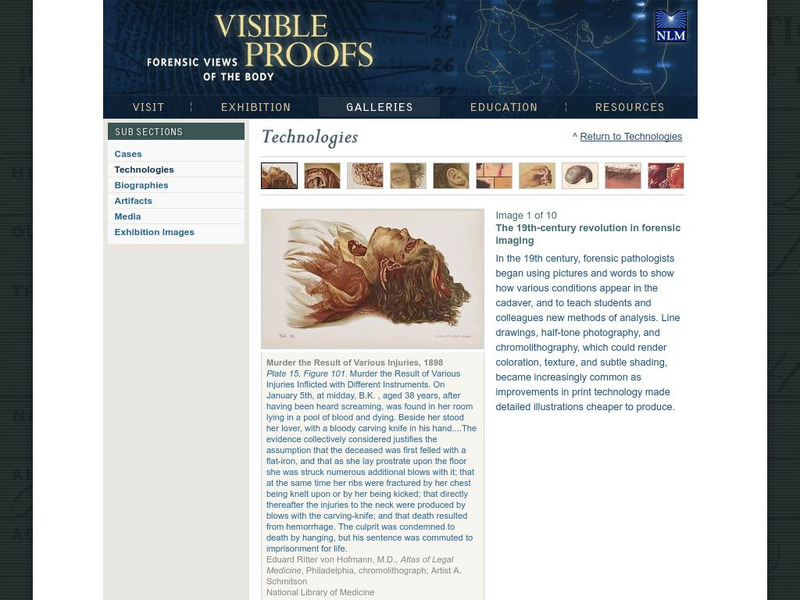Other
International High Technology Crime Investigation Association
This site is devoted to high technology crime investigations and contains training and seminars as well as a variety of resources.
TED Talks
Ted: Ted Ed: Early Forensics and Crime Solving Chemists
In a CSI age, we take forensic science for granted. New York did not have a medical examiner or forensic toxicologist until 1918, whose eventual arrival changed the landscape of crime investigation forever. Deborah Blum prompts the TED...
Georgia Department of Education
Ga Virtual Learning: Crime Science Investigation
In this comprehensive interactive tutorial you will learn the basic components of a crime scene investigation and how they are implemented. You will also learn various evidence collecting techniques, as well as how to properly document...
Federal Bureau of Investigation
Federal Bureau of Investigation
The Federal Bureau of Investigation(F.B.I)is an independent agency of the U.S. government. This homepage contains a wide variety of information, such as: Your FBI, Contacting the FBI, Major Investigations, Employment, etc.
CNN
Cnn: Novak: 'No Great Crime' With Leak
The author of the column at the center of the Valerie Plame CIA leak scandal, Robert Novak, defends his article, the White House, and says there was no crime committed in this October, 2003, article.
University of Arizona
The Biology Project: Human Biology: Dna Forensics Problem Set 1
Students have the opportunity to interpret actual case results from the use of the Restriction Fragment Length Polymorphism (RFLP) method to characterize human DNA samples as applied in paternity analysis and sex crimes investigations.
University of Arizona
The Biology Project: Human Biology: Dna Forensics Problem Set 2
Students practice a problem using DNA profile analysis to characterize human DNA samples as applied in paternity analysis and sex crimes investigations.
Indiana University
A Crime Against Plants
Have your students delve into the evidence involving a small tree and arrive at an explanation of what happened in this thorough lesson plan site. .
Cyberbee
Cyberbee: Who Dunnit?
If you are a crime scene investigation (CSI) fan, then you will love this site! You get to be the detective by examining the evidence, viewing the crime scene, dusting for fingerprints, interviewing the suspects, and solving the crime.
Other
Streetlaw: Criminal Law and Juvenile Justice
The chapters of this unit on criminal law and juvenile justice are as follows: "Crime in America," "Introduction to Criminal Law," "Crimes Against the Person," "Crimes Against Property," "Defenses," and "The Criminal Justice Process: The...
PBS
Pbs Learning Media: Un(re)solved: Frontline: Interactive
Un(re)solved tells the stories of lives cut short and examines a federal effort to investigate more than 150 cold cases that date back to the civil rights era. Learn about and speak the names of the many people whose lives were lost...
Federal Bureau of Investigation
Fbi Records: The Vault: Eliot Ness
Enter this electronic reading room to peruse scanned historical documents about the work of Eliot Ness and his fight against organized crime.
Chemistry Collective
Chem Collective: Mixed Reception
Participate in the investigation of a virtual crime scene using chemistry concepts to solve a mysterious death. The 40-50 minute activity can be used as a classroom lab or as a homework assignment. Additionally, teachers may request a...
Science Education Resource Center at Carleton College
Serc: Chromatography: Who Wrote the Note?
Students investigate who stole the class pet by testing the chromatograph of different markers as a way to find the evidence that points to the perpetrator.
Other
Crime Scene Investigation: Proper Tagging and Labeling of Evidence
What is the purpose of tagging and labeling items of evidence? What information belongs on the tag? These questions are answered in this concise but competent site.
PBS
Pbs Treasures of the World: Theft of the "Mona Lisa"
A PBS site describes the 1911 theft of the "Mona Lisa." Retells the story of the crime, investigates the suspects, and traces its return to the Louvre.
Science Education Resource Center at Carleton College
Serc: Chemical Reactions: Was the Blood at the Scene the "Real Mc Coy"?
The activity listed below comes well into the middle of a unit study. Upon studying a "crime scene" and the evidence provided, the students are to take notes, study photos or drawings, look at suspect alibis and statements and then...
Natural History Museum
Natural History Museum: On Maggots and Murders: Forensic Entomology [Pdf]
Five-page article explains how forensic scientists, when investigating crimes, analyze maggots and blowflies to determine approximate times of death.
University of Arizona
University of Arizona: Adn en Medicina Legal 1
Learn about the polymorphism method to characterize human DNA samples as applied in the analysis of paternity and sex crimes investigations. You will have the opportunity to interpret results as those obtained in the FBI laboratory or a...
University of Arizona
University of Arizona: Adn en Medicina Legal 2
Learn about the polymorphism method to characterize human DNA samples as applied in the analysis of paternity and sex crimes investigations. You will have the opportunity to interpret results as those obtained in the FBI laboratory or a...
National Institutes of Health
National Library of Medicine: The Bertillon System
Bertillon devised a system to make order out of the myriad of crime scene photos taken by the police. This brief site describes how that system worked and shows a number of crime scene photos taken from Bertillon's photo album.
National Institutes of Health
National Library of Medicine: The 19th Century Revolution in Forensic Imaging
In the 19th century, forensic pathologists began to use words and pictures to describe cadavers and to teach using cadavers in the classroom. See a number of interesting photos of various crime scenes on this interesting site.
Virtual Museum of Canada
Virtual Museum of Canada: Virtual Exhibit on Forensic Science
Discover the components of forensic science. There is also a link to a simulation in which you can apply your skills to solve a crime.
TeachEngineering
Teach Engineering: Who Robbed the Bank?
Students use DNA profiling to determine who robbed a bank. After they learn how the FBI's Combined DNA Index System (CODIS) is used to match crime scene DNA with tissue sample DNA, students use CODIS principles and sample DNA fragments...


















